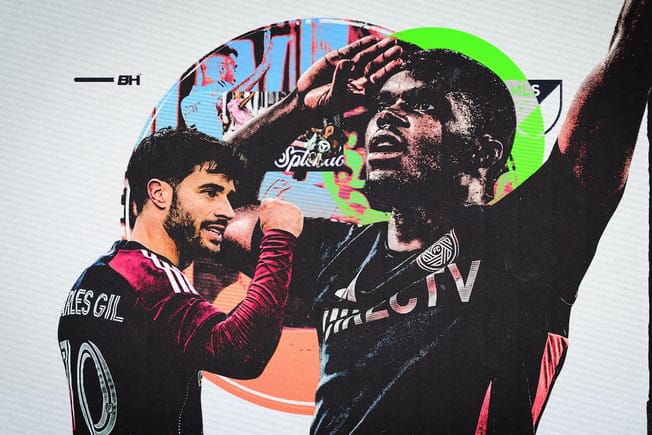If you’re a team with ambition in today’s MLS and you want to improve your roster, you really only have one option that allows you to spend as much as you want. You’ll have to take advantage of the Designated Player rule.
With this roster mechanism, teams in MLS can sign up to three Designated Players. Clubs are allowed to spend unlimited amounts of money on transfer fees and salaries for those players, but only the first $612,500 (in most cases) counts against the salary cap.
It essentially gives teams the ability to spend whatever they want to get three potential star players.
The original intent of the Designated Player rule was to allow teams (or just the LA Galaxy) to sign big-name superstars while still suppressing the salaries of the mostly domestic players on MLS rosters. In modern times, teams generally still use it for dynamic offensive weapons not typically found in the domestic player pool.
However, the DP rule has become antiquated. Clubs are not as concerned with signing big names and the rule is now hurting the league in many ways, rather than helping it.
Let’s look at why, 15 years after it was invented, it might be time to end the Designated Player rule.
HIGH RISK, SOMETIMES HIGH REWARD
The significant downside of the Designated Player rule is that investing a large sum of money in only three players – instead of being able to spread that money out across an entire roster – is a very risky proposition.
Any good investment advisor will tell you about the importance of diversifying your portfolio. You want to balance risk and reward by having a range of assets to limit the long-term volatility of your investments. If you put all your money in a single asset and that investment takes a nosedive, you’re going to be in a world of hurt. That same principle applies to the DP rule. If a DP doesn’t perform or gets hurt, your team could be out millions of dollars with little to nothing to show for it.
This is something that Sporting Kansas City has learned the hard way this year. In January, the club announced that DP striker Alan Pulido would likely miss the entire 2022 season after undergoing knee surgery. Two weeks ago, the club also announced that a second DP, attacking midfielder Gadi Kinda, would also undergo knee surgery and be out for the season. Even though those players are injured, Kansas City cannot sign any additional Designated Players.
Instead of being a fun, attacking team with Pulido up front and Kinda in the midfield alongside wingers Johnny Russell and Daniel Salloi, SKC has plummeted to the bottom of MLS. There are many things wrong with SKC right now, but it’s hard to understate the impact of losing Pulido and Kinda.
The stats show Sporting’s offense is in a free fall. They have the second lowest goals scored per 90 minutes total in MLS and they’re only averaging 0.99 expected goals per 96 minutes, according to American Soccer Analysis. With Alan Pulido, one of the most expensive inbound transfers in league history, being replaced by Khiry Shelton up front, it shouldn’t be a shock to see Sporting Kansas City’s low attacking numbers.
This situation would have been mitigated if SKC had been able to spread out the eight figures that they spent on DPs across their entire roster. SKC can and have taken advantage of Targeted Allocation Money (TAM) and the recently introduced U22 Initiative to add talent, but the point stands.
Successful soccer teams require depth. If MLS teams could more evenly distribute their roster spending, they could add more of that depth.
COMPETING WITH LIGA MX
One hot topic in MLS circles is competition with Liga MX. Frankly, more needs to be done for MLS to have a realistic opportunity to compete year in and year out against Liga MX teams in the CCL and in next year’s newly revamped Leagues Cup.
The Seattle Sounders winning the Concacaf Champions League should be a watershed moment for the league, but in reality, it might not be. It’s important to note that Pumas, the team that the Sounders beat in the CCL Final, were bounced in the first round of the Clausura playoffs. They weren’t among Mexico’s best or brightest this season. They weren’t one of the big spenders, either.
It’s easy to point to the lack of a salary cap as a big advantage for Liga MX, but it’s the contrast in how the Mexican clubs spend money that is more salient. Liga MX teams don’t always use their lack of a salary cap to spend on big names. No, they often use it to spend more broadly across multiple positions.
To Seattle’s credit, Garth Lagerwey assembled one of the deepest teams in MLS history to win the Champions League, but that win still came at a cost. I mentioned earlier this month in my Expected Goals article that Seattle basically punted the beginning of the MLS regular season. They’re currently still near the bottom of the xG differential table with a -0.79 xGD per game.
The Sounders also lost arguably the best defensive midfielder in MLS when João Paulo tore his ACL during the second leg of the final against Pumas. Now, partially due to a lack of resources, they’re primarily looking to replace him with teenagers from their academy. Even with all of their depth relative to other teams in MLS, the Sounders still had issues navigating multiple competitions at the same time.
We also see a lack of roster depth and quality impacting MLS in other competitions, including the U.S. Open Cup. Teams like Seattle and the Philadelphia Union lost in the Open Cup’s Round of 32 because, at least in part, they chose to rotate their squads and save their best players for the weekend. If the money spent on DPs was more evenly spread out, this would become less of an issue.
MLS’S TV PROBLEM
An inability to maximize efficient spending to elevate the league’s on-field product also contributes to one of MLS’s other big problems: not enough people are watching MLS on TV.

Source: Sports Business Journal
As reported by The Athletic, MLS only makes between $60 and $65 million per season on their current TV deal, which finishes at the end of the season. Recent reporting, also by The Athletic, doesn’t paint an optimistic picture on negotiations for a new deal, either.
One of the keys to MLS’s long-term success is selling the idea that once soccer makes it in the United States, MLS will become one of the top soccer leagues in the world and will join traditional American sporting powerhouses like the MLB, NHL, and others.
For that to happen, executives must figure out a way to get people to watch the league on TV. Based on the ratings, it doesn’t seem like the Designated Player strategy is accomplishing that goal. In 2022, soccer fans almost have too many options to watch soccer, and it’s safe to say that Xherdan Shaqiri playing on the most boring team in MLS or Gonzalo Higuain smoking cigarettes on the bench at Inter Miami is not a product that the non-hardcore MLS fan wants to see.
Even if Leo Messi joins MLS, the best way to get those eyeballs to tune in is to improve the consistency of the product on the field. Perhaps the easiest way to do that is by getting rid of the DP rule and redistributing those dollars from the few to the many, subsequently decreasing the gap in player quality from the stars to the benchwarmers.
Will MLS make the leap to change or eliminate the Designated Player rule? It seems unlikely, at least in the near future. However, finding ways to increase strategic roster spending will be critical to the league’s future growth.







Comments